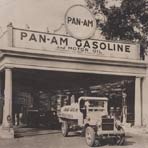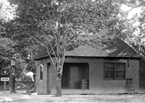
The Automobile Shapes The City
Filling Stations and Other Services
The stamp of the automobile on the city was not restricted to the vehicles, streets and roads, parking spaces, and traffic signs and lights. Like horses that needed hay and stables, like trains that needed water, coal, and terminals, automobiles needed gas and oil, replacement parts, tires and batteries, and garages. Most important of all they needed filling stations and service stations. In the early days of the automobile, travel required careful planning. Initially, gasoline had to be obtained at “bulk depots” located outside of the cities. Fuel was provided in cans or other containers, but ultimately wholesalers transported gasoline in horsedrawn tank trucks to commercial customers in towns for sale to motorists. In 1905 the Automobile Gasoline Company in St. Louis employed a gravity-fed tank for fueling cars and opened the first “gas station.” Petroleum giant Standard Oil opened its first station in Seattle in 1907.
As automobile sales increased, the demand for fuel led to a more systematic way of delivering it, and in 1914 Standard Oil of California opened a chain of 34 homogeneous stations along the West Coast. Major oil companies moved quickly to secure their own gas dealers, made possible by technical advances in gasoline pumps. Soon pumps were being installed not only at the new service stations, but in front of hardware stores, feed companies, livery stables, and a variety of other retailers. Curbside pumping was less common in the countryside. The early service stations along the roadside might be converted barns, stables, warehouses, or poorly constructed shacks and shanties. Downtown garages, curbside gas stations, and automobile showrooms, however, often conformed to the “Main Street” building style. Although curbside pumping was convenient, it often blocked trolley tracks and created traffic snarls and was thus gradually replaced by “drive-in” facilities that required motorists to get their vehicles off the street to obtain the services required. Such an arrangement was novel, rarely required of buildings and structures before that time. Accommodation to the automobile, therefore, took on a new meaning.
Super service stations were important elaborations of the original filling stations. Introduced in Los Angeles prior to World War I, super service stations combined operations that had been handled separately. Before that time, a motorist went one place for gas and oil, and other places for lubrication and cleaning, for repairs, or for tires and other accessories. Combining these activities was convenient for consumers and opened up new marketing possibilities for those interested in taking advantage of the boom in automobiles. The earliest known super service station—Service Town—was built in 1914, three miles from downtown Los Angeles. Several of these stations were constructed in southern California in the early 1920s and soon spread across the country.
The concept of one-stop shopping for automobile services was particularly attractive outside the most populous city areas, where a wide variety of individual businesses were unlikely to congregate. In the 1920s other facilities geared to the automobile, such as drive-in markets and many other “drive-in” establishments, began to appear, suggesting the degree to which the car had entered the consumer market not as a toy for the rich, but as a crucial means of private transportation. Cities that had already been covered with signs selling all kinds of products were inundated with more and larger commercial signs in the automobile age to attract the attention of passengers in speeding vehicles.
A good example of an automobile-specific commercial outlet was the car wash, or auto laundry, as it was sometimes called. The first of these were not automated, but offered stationary car racks so that the undercarriages as well as sides and tops could be cleaned of dirt and grime from the road and from the operation of the vehicles themselves. As early as 1922, experiments with larger facilities were attempted. In St. Paul, Minnesota, one garage had a “wash bowl” where cars could be driven around in a flooded basin to soak the underbody and then moved to racks for further cleaning.
<<Previous Section - Next Section>>
Introduction
The “Footprint” of the Automobile on the American City
From “Walking Cities” to “Automobile Cities"
Filling Stations and Other Services
Expressways, Freeways, and Superhighways
Complete Text Printable View
About the Project | Credits | Contact Us | Student & Teacher Resources | Site Map
©2004-2010 Automobile in American Life and Society

